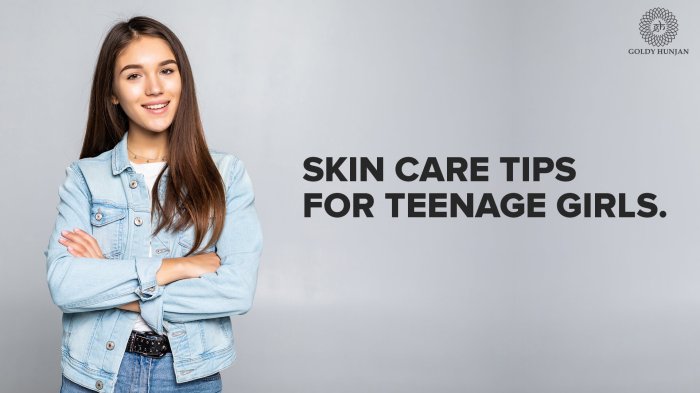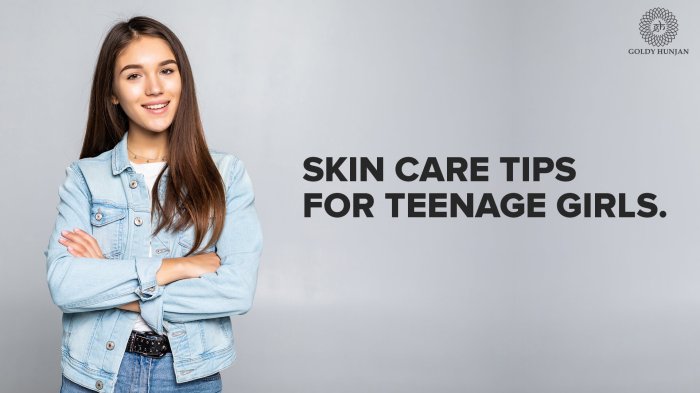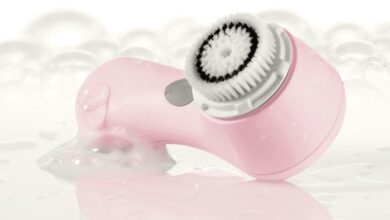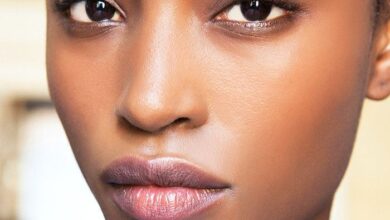
Teen Skin Care Tips: A Guide for Clear and Confident Skin
Teen skin care tips are essential for navigating the unique challenges of adolescent skin. This stage of life is marked by hormonal fluctuations, increased oil production, and the emergence of acne, leaving many teens feeling self-conscious about their complexion.
This guide will equip you with the knowledge and tools to embrace your skin and achieve a healthy, radiant glow.
We’ll delve into the intricacies of teen skin, from understanding its unique characteristics to building a personalized skincare routine. You’ll learn how to combat acne, protect your skin from the sun, and adopt healthy habits for clear skin. We’ll also debunk common skincare myths and provide a comprehensive list of essential products for every budget.
Understanding Teen Skin
Teenage years are a time of significant change, both physically and emotionally. As your body undergoes rapid growth and development, your skin also experiences a transformation. Understanding these changes and how they affect your skin is crucial for maintaining a healthy complexion and preventing common skin problems.
Hormonal Changes and Oil Production
Hormonal fluctuations during puberty play a major role in the changes your skin undergoes. The increased production of hormones like testosterone and estrogen can lead to increased sebum production, the oily substance that lubricates your skin. While sebum is essential for healthy skin, an overproduction can clog pores and lead to acne breakouts.
Common Skin Concerns for Teens
The increased oil production and hormonal changes during puberty contribute to several common skin concerns for teenagers, including:
- Acne:Acne is a common skin condition characterized by pimples, whiteheads, blackheads, and cysts. It occurs when oil, dead skin cells, and bacteria clog hair follicles.
- Breakouts:Breakouts are a common form of acne that can occur on the face, back, chest, and shoulders. They can be caused by various factors, including hormonal fluctuations, stress, and poor hygiene.
- Oily Skin:Oily skin is a common characteristic of teenage skin. It can be caused by an overproduction of sebum, which makes the skin appear shiny and greasy.
Identifying Your Skin Type
Understanding your skin type is crucial for choosing the right skincare products and routines. Teenagers often have oily skin, but it’s important to identify your specific type to address your individual needs.
- Oily Skin:Oily skin produces excessive sebum, making it appear shiny and greasy. You may experience frequent breakouts and have large pores.
- Dry Skin:Dry skin lacks moisture and can feel tight and flaky. It may be sensitive to certain products and prone to irritation.
- Combination Skin:Combination skin has both oily and dry areas. The T-zone (forehead, nose, and chin) is typically oily, while the cheeks and other areas are dry.
- Sensitive Skin:Sensitive skin is easily irritated by products and environmental factors. It may be prone to redness, itching, and burning.
Building a Basic Skincare Routine: Teen Skin Care Tips
Building a consistent skincare routine is essential for maintaining healthy and radiant skin. It’s not about using a ton of products; it’s about choosing the right ones and applying them regularly. Start with a simple routine that addresses your skin’s needs, and gradually add products as you understand your skin better.
Morning Skincare Routine
A morning routine helps to refresh your skin and prepare it for the day.
- Cleanse:Start with a gentle cleanser to remove any excess oil, sweat, or impurities that may have accumulated overnight. Look for cleansers that are oil-free, non-comedogenic (won’t clog pores), and pH-balanced. Examples include CeraVe Foaming Facial Cleanser or La Roche-Posay Toleriane Hydrating Gentle Cleanser.
- Moisturize:Hydration is crucial for maintaining skin’s health and preventing dryness. Choose a lightweight moisturizer that absorbs quickly and leaves no greasy residue. Look for moisturizers that contain hyaluronic acid, which attracts and holds moisture. Examples include Cetaphil Daily Facial Moisturizer with SPF 15 or Neutrogena Hydro Boost Water Gel.
- Sun Protection:Sun protection is the most important step in any skincare routine, regardless of your skin tone or age. Apply a broad-spectrum sunscreen with an SPF of 30 or higher every day, even on cloudy days. Look for sunscreens that are lightweight, non-greasy, and suitable for your skin type.
Examples include Supergoop! Unseen Sunscreen SPF 40 or EltaMD UV Clear Broad-Spectrum SPF 46.
Nighttime Skincare Routine
A nighttime routine focuses on repairing and rejuvenating your skin while you sleep.
Teenage skin is a battlefield, with breakouts and oiliness constantly vying for attention. But don’t despair! There are amazing tools and products out there to help you win the war. I’ve been loving the hsn faves for getting you back – they’ve got everything from gentle cleansers to powerful spot treatments.
Once you’ve got your arsenal together, remember to be patient and consistent – clear skin is a journey, not a destination!
- Cleanse:Remove makeup and impurities with a gentle cleanser, similar to your morning routine.
- Exfoliate:Exfoliation helps to remove dead skin cells and promote cell turnover, revealing brighter and smoother skin. Exfoliate 1-2 times a week, depending on your skin’s sensitivity. Choose a gentle exfoliating scrub or chemical exfoliant with ingredients like salicylic acid or glycolic acid.
Examples include St. Ives Apricot Scrub or The Ordinary Salicylic Acid 2% Masque.
- Targeted Treatments:If you have specific concerns like acne, dryness, or uneven skin tone, you can incorporate targeted treatments into your routine. For acne, consider using a spot treatment with benzoyl peroxide or salicylic acid. For dryness, use a hydrating serum or face mask.
For uneven skin tone, try a vitamin C serum. Remember to patch test any new product before applying it to your entire face.
Acne Management

Acne is a common skin condition that affects most teenagers. It occurs when hair follicles become clogged with oil and dead skin cells. While acne is a normal part of growing up, it can be frustrating and sometimes even painful.
Understanding the causes and types of acne can help you manage it effectively.
Taking care of your skin is essential, especially as a teen. From keeping your face clean to using sunscreen, there are plenty of simple things you can do to have healthy, glowing skin. And don’t forget about your wardrobe! A stylish fall look doesn’t have to be expensive, check out these 12 fall wardrobe ideas that won’t break the bank for some inspiration.
Once you’ve got your outfit sorted, remember to keep your skin protected from the elements, especially as the weather starts to change.
Causes of Acne
Acne is primarily caused by a combination of factors, including:
- Hormonal Changes:During puberty, your body produces more hormones, such as testosterone, which can stimulate oil production in the skin.
- Excess Oil Production:The oil glands in your skin, called sebaceous glands, produce sebum, which helps keep your skin moisturized. But excessive sebum production can clog hair follicles and lead to acne.
- Dead Skin Cells:Dead skin cells can accumulate in hair follicles and trap oil, contributing to acne breakouts.
- Bacteria:A type of bacteria called Propionibacterium acnes (P. acnes) lives on your skin. When hair follicles are clogged, P. acnes can multiply and cause inflammation.
Types of Acne
Acne can manifest in various forms:
- Blackheads:These are open comedones, meaning the pore is open to the surface of the skin. The trapped sebum and dead skin cells oxidize, giving them a black appearance.
- Whiteheads:These are closed comedones, where the pore is blocked by a plug of sebum and dead skin cells. The trapped sebum remains white under the skin’s surface.
- Papules:These are small, red, and inflamed bumps that are tender to the touch. They are caused by inflammation of the hair follicle.
- Pustules:These are similar to papules but contain pus, which is a mixture of white blood cells and bacteria. They appear as white or yellow bumps surrounded by red inflammation.
- Cystic Acne:This is the most severe form of acne, characterized by large, deep, painful cysts that can leave scars.
Importance of Regular Cleansing and Gentle Exfoliation
Regular cleansing and gentle exfoliation are essential for preventing acne breakouts.
Taking care of your skin is super important, especially as a teen. From cleansing to moisturizing, it’s all about finding the right routine. And while we’re on the topic of self-care, don’t forget about your nails! A great way to add a touch of polish is with a perfectly manicured nails under 10 , and it’s surprisingly affordable.
Just like with your skin, keeping your nails healthy and looking good can boost your confidence. So, go ahead, pamper yourself!
- Cleansing:Washing your face twice a day with a gentle cleanser helps remove excess oil, dirt, and bacteria that can clog pores. Choose a cleanser that is specifically designed for acne-prone skin.
- Exfoliation:Exfoliating removes dead skin cells that can clog pores. Use a gentle scrub or chemical exfoliant 1-2 times per week.
Choosing the Right Acne Treatments
There are numerous acne treatments available, both over-the-counter and prescription.
Over-the-Counter Acne Treatments
- Benzoyl Peroxide:This is a common acne treatment that kills bacteria and helps reduce inflammation. It can be found in various concentrations, with higher concentrations generally being more effective.
- Salicylic Acid:This is a beta-hydroxy acid (BHA) that helps unclog pores and reduce inflammation. It is often found in acne washes, toners, and spot treatments.
- Sulfur:This is a natural ingredient that helps dry out excess oil and reduce inflammation. It is often found in acne masks and spot treatments.
Prescription Acne Treatments
If over-the-counter treatments are not effective, your dermatologist may prescribe stronger medications, such as:
- Retinoids:These are vitamin A derivatives that help unclog pores, reduce oil production, and prevent acne breakouts.
- Antibiotics:These help kill bacteria that can cause acne.
- Oral Contraceptives:For women, oral contraceptives can help regulate hormones and reduce acne.
- Isotretinoin:This is a powerful oral medication that is reserved for severe cases of acne. It can have serious side effects, so it is only prescribed in extreme situations.
Sun Protection
The sun’s rays, while providing essential vitamin D, can also be harmful to your skin. Teenagers, with their active lifestyles and time spent outdoors, are particularly susceptible to sun damage. This can lead to premature aging, sunburns, and even skin cancer.
The Importance of Sun Protection
Protecting your skin from the sun’s harmful rays is crucial. Sun damage, often occurring during teenage years, can have long-term consequences. Exposure to ultraviolet (UV) radiation can cause premature aging, characterized by wrinkles, age spots, and leathery skin.
Furthermore, excessive sun exposure increases the risk of developing skin cancer, a serious health concern.
Recommended SPF Level
For optimal protection, dermatologists recommend using a broad-spectrum sunscreen with an SPF of at least 30. SPF stands for Sun Protection Factor, and a higher SPF number indicates greater protection. Broad-spectrum sunscreens protect against both UVA and UVB rays, which are responsible for different types of skin damage.
UVA rays penetrate deeply into the skin, contributing to wrinkles and premature aging, while UVB rays cause sunburns.
Incorporating Sunscreen into Daily Routines
Make sunscreen application a habit, like brushing your teeth. Apply sunscreen liberally to all exposed skin, including your face, neck, ears, and hands, 20 minutes before going outdoors. Reapply every two hours, especially after swimming, sweating, or towel drying.
Reapplying Sunscreen Throughout the Day
Sun protection is not a one-time event. Reapplying sunscreen is essential, especially during prolonged outdoor activities. Carry a small bottle of sunscreen in your bag or backpack for easy access. Remember, sunscreen is most effective when applied consistently and reapplied regularly.
Healthy Habits for Clear Skin
Beyond skincare products, maintaining a healthy lifestyle plays a crucial role in achieving clear and radiant skin. By incorporating these healthy habits into your daily routine, you can support your skin’s natural functions and enhance its overall appearance.
Diet and Hydration
A balanced diet rich in fruits, vegetables, and whole grains provides essential vitamins, minerals, and antioxidants that nourish the skin from within. These nutrients help to protect against damage caused by free radicals, promote collagen production, and maintain skin hydration.
- Fruits and vegetables: Fruits and vegetables are packed with vitamins A, C, and E, which are essential for skin health. Vitamin A promotes cell growth and repair, vitamin C is a powerful antioxidant that protects against sun damage, and vitamin E helps to keep skin hydrated.
- Whole grains: Whole grains are a good source of fiber, which helps to regulate digestion and reduce inflammation. They also provide B vitamins, which are essential for cell growth and energy production.
- Water: Staying hydrated is crucial for maintaining skin elasticity and plumpness. Water helps to flush out toxins and keep skin cells hydrated, giving it a healthy glow. Aim to drink at least eight glasses of water per day.
Stress and Sleep
Chronic stress can trigger the release of hormones that can lead to inflammation and breakouts. Adequate sleep is essential for skin repair and regeneration.
- Stress management techniques: Practice stress-reducing activities like yoga, meditation, or deep breathing exercises. Engage in hobbies you enjoy to de-stress and unwind.
- Sleep hygiene: Aim for 7-9 hours of quality sleep each night. Create a relaxing bedtime routine, avoid screen time before bed, and ensure your bedroom is dark, quiet, and cool.
Regular Exercise
Regular exercise improves blood circulation, which delivers oxygen and nutrients to the skin cells, promoting a healthy complexion. Exercise also helps to reduce stress and improve sleep quality, both of which benefit skin health.
- Cardiovascular exercise: Engage in activities like running, swimming, or cycling that elevate your heart rate and improve blood flow.
- Strength training: Include strength training exercises to build muscle and boost metabolism, which can help to improve skin tone and elasticity.
Common Skincare Myths
Navigating the world of skincare can be overwhelming, especially for teens. With countless products and conflicting advice, it’s easy to fall prey to common myths that can actually harm your skin. Let’s debunk some of these myths and empower you with evidence-based information for healthy and glowing skin.
Popping Pimples
Popping pimples might seem tempting, but it’s a big no-no. While it might feel satisfying in the moment, it can actually worsen the situation and lead to more breakouts, scarring, and even infections.
- Spreading bacteria:Popping pimples can spread bacteria from the infected area to surrounding skin, leading to more breakouts.
- Increased inflammation:The pressure from popping can cause further inflammation, making the pimple redder and more noticeable.
- Scarring:Picking and squeezing can damage the skin, leading to permanent scars.
- Infections:Popping pimples can introduce bacteria into the skin, leading to infections like cellulitis.
Instead of popping pimples, focus on keeping your skin clean and using gentle spot treatments. Consult a dermatologist for personalized advice on managing acne and preventing scarring.
Harsh Scrubs, Teen skin care tips
Harsh scrubs might seem like a good way to remove dead skin cells and achieve a brighter complexion, but they can actually irritate your skin and make it more prone to breakouts.
- Skin irritation:The abrasive particles in harsh scrubs can scratch and irritate the skin, leading to redness, dryness, and even breakouts.
- Increased oil production:Scrubbing can disrupt the skin’s natural barrier, leading to increased oil production and more breakouts.
- Microtears:Harsh scrubs can create microscopic tears in the skin, making it more vulnerable to bacteria and infections.
Instead of using harsh scrubs, opt for gentle exfoliating products with smaller particles or chemical exfoliants like salicylic acid or glycolic acid. These ingredients work effectively to remove dead skin cells without causing irritation.
Skincare Essentials for Teens
Now that you understand the basics of teen skin and have a skincare routine in place, let’s delve into the essential products that can help you achieve your skin goals. Remember, every individual’s skin is unique, so it’s important to find products that work best for you.
Essential Skincare Products
Here’s a list of essential skincare products for teens, along with examples for different skin types and budgets:
| Product Category | Description | Examples |
|---|---|---|
| Cleanser | A cleanser removes dirt, oil, and makeup from your skin. It should be gentle and pH-balanced. |
|
| Moisturizer | A moisturizer helps to hydrate your skin and prevent dryness. Choose one that is non-comedogenic (won’t clog pores). |
|
| Sunscreen | Sunscreen is crucial for protecting your skin from harmful UV rays. Choose one with an SPF of 30 or higher and broad-spectrum protection. |
|
| Exfoliating Scrub/Mask | Exfoliation helps to remove dead skin cells and unclog pores. Use a gentle scrub or mask 1-2 times a week. |
|
| Acne Treatment | An acne treatment helps to reduce breakouts and prevent future ones. Choose one with ingredients like salicylic acid or benzoyl peroxide. |
|
| Spot Treatment | A spot treatment helps to dry out pimples and reduce redness. Look for products with salicylic acid or tea tree oil. |
|




